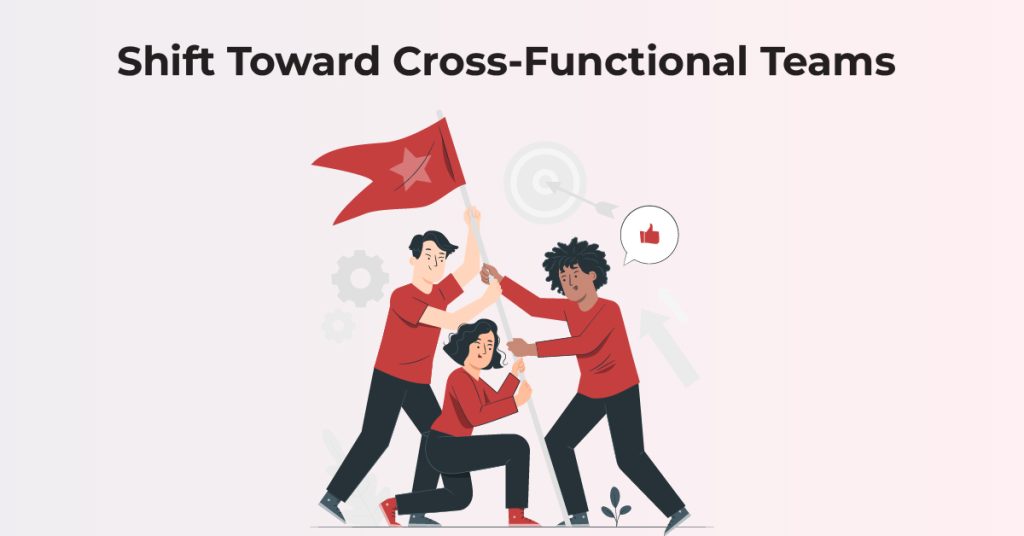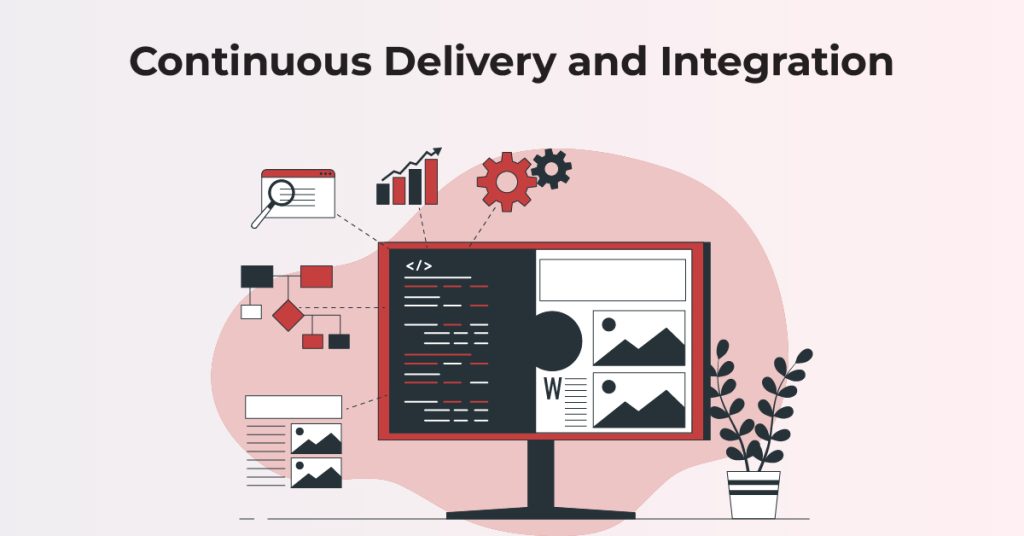Let’s explore the key IT shifts in Scaled Agile organizations. These will help you be more efficient, creative, and collaborative, which will improve your performance in competitive markets.

Organizations need to enhance their adaptability alongside capacity enhancement to remain competitive and respond to today’s fast-moving digital environment. Successful application of Agile principles depends on the Scaled Agile Organizations Framework IT changes. Through this structure, organizations can expand Agile IT practices among different teams.
A Scaled Agile Transformation implements comprehensive alterations to IT infrastructure. Agile transforms technology creation and delivery systems and organizational leadership models. This article looks at five key IT shifts in Agile organizations. These shifts help change how businesses approach IT strategy execution.
What Are Scaled Agile Organizations?
Scaled Agile Organizations adopt Agile practices within their complex multi-team systems, which helps them span many departments and units. Large enterprises also adopt Agile frameworks to develop team collaboration among dispersed business units.
The Essence of the Scaled Agile Framework (SAFe)
The Scaled Agile Framework (SAFe) is a well-known method that applies Agile principles at the corporate level. It supports flexible teamwork between many connected teams without confusing business objectives.
The framework helps all organizational teams, including—
- Development
- Quality assurance and
- Operations teams
They must unite around common project goals. Business success through Scaled Agile requires aligned Agile teams to operate together, which helps create effective outcomes.
The alignment mechanism enables teams to advance corporate direction instead of operating independently. Agile IT transformation helps organizations improve their operational effectiveness while delivering faster.
These organizations install these specific traits:
- Cross-Functional Teams: A Scaled Agile Organization operates using cross-functional teams. These teams comprise people with diverse abilities who work as one unit to create value. Scaled Agile teams work together during sprint cycles and development iterations, which helps cut loose connections between operating departments.
- Focus on Continuous Delivery: Organizations that adopt Scaled Agile build continuous value delivery. Teams now distribute a series of more minor updates instead of delaying for one big release. Thus, customers can experience immediate feedback through testing.
- Alignment with Business Strategy: Agile organizations help Agile teams perform seamless work, which advances the company’s strategic business objectives. Different Agile frameworks, including the SAFe framework, have made clear communication and team collaboration essential.
5 Key IT Shifts in Agile Organizations
1. Adoption of Agile IT Practices Across IT Teams

Agile practices now permeate throughout all IT groups in Scaled Agile Organizations. This accessible IT structure helps these groups function differently but more efficiently. IT teams operate within separate development and operations silos. This prevents them from meaningful collaboration. This method causes delays and inefficiencies, breaking development-related targets.
Agile IT practices encourage teams to improve through constant enhancement and open communication. They aim for better outcomes. The Scaled Agile model uses Agile principles to unite development, test, and ops teams. It aims to improve team communication and collaboration.
Agile IT practices equip project teams to function through iterative sprints. This is done alongside stand-up meetings, implementing continuous integration and continuous delivery.
Case Study:
Spotify’s adoption of its self-made Scaled Agile Framework shows that Agile IT practices work. This gives cross-functional squads a flexible, adaptive operational method. The organization expanded its Agile methods throughout its IT units, enabling quick innovation while maintaining high-quality standards.
2. Shift Toward Cross-Functional Teams

Adopting cross-functional teams marks a significant IT transformation in Scaled Agile organizations. The historic IT department model has independent personnel in silos, such as:
- Developers,
- Testers,
- Network engineers and
- System administrators.
By implementing Scaled Agile Transformation, organizations drop silos while forming teams. Hereby, contributors maintain diverse skill sets that collaborate to produce value.
The teams have complete authority to guide all product stages, including everything from raw materials to final product delivery. Team reorganization leads to less waiting at workstations, boosting decision-focused productivity and team collaboration.
Case Study:
The global financial services organization ING demonstrates the advantages of using cross-functional teams. The Scaled Agile Framework (SAFe) became ING’s platform for changing technology operations. This resulted in the team structure being updated to follow Agile principles. Autonomous teams at ING sped up product market time and led to better customer outcomes.
3. Continuous Delivery and Integration

Traditional IT platforms release software through extensive collective packages that appear rarely. Such delays cause a backlog of features, bugs, and requests. Long-release cycles present two challenges:
- The accumulation of more issues and
- The difficulty of successful testing and deployment increased during that period.
Organizations adopt Agile IT practices with the Scaled Agile Framework, which helps them move to continuous integration (CI) and continuous delivery (CD). Such methods permit teams to distribute application updates several times per cycle, using small and sequential deployments instead of large singular releases.
This change boosts quality, speeds delivery times, and improves real-time client responses. Fast value delivery and quick customer responses create high quality and stability.
Case Study:
Amazon uses automated testing and deployment, which lets customers get real-time code updates. Netflix innovates quickly by using agile practices in its framework. It also maintains stable platforms when deploying new features.
4. Increased Focus on Automation and DevOps Practices

Agile practice success depends on automation as organizations expand their implementation scope. Agile IT transformation depends on DevOps, which merges automated software development with IT operations. Automation has simplified processes and lowered human error rates, thus accelerating software production speed.
Our Scaled Agile organizations need DevOps practices because they make our software releases quicker and more efficient. When IT teams automate basic development tasks, they free up resources, allowing them to focus on important business tasks.
Through DevOps, operational teams develop unified efforts with development teams, reducing the traditional divisions between these departments.
Case Study:
Amazon Web Services (AWS) applies comprehensive DevOps frameworks throughout its worldwide infrastructure. By implementing automated deployment pipelines, AWS delivers high-quality services on a vast scale. DevOps transformation, together with automation, enhances AWS’s capability. This helps AWS release updates and new features to its customers at a quicker pace.
5. Data-Driven Decision-Making and Agile IT Metrics

Organizations using scaled agile now center their IT transformations on data structures, which support their decision-making processes. In the past, IT environments used intuition to decide on product development and IT strategy.
Since adopting Agile IT, companies have used real-time data analytics to make decisions. Scaled Agile organizations value data that measures Agile team results and IT operations. They want to analyze these data points.
The metrics help IT leaders make decisions. They show team efficiency, response times, and customer satisfaction. This boosts business results.
Case Study:
Capital One shows how a company can use data to guide its Agile transformation. The financial services firm applied Agile principles to its IT teams. It measured their speed and defect rates using data collection. Capital One used these insights to maximize development processes. It also contributed to increasing productivity and achieving accelerated innovation speeds.
Benefits of Key IT Shifts in Agile Organizations
Many IT changes in Scaled Agile firms improve operations. They provide a competitive edge in today’s digital world. Let us look at some benefits, emphasizing the role of these shifts in an Agile IT transformation:
Increased Innovation and Adaptability
Agile IT practices help Scaled Agile organizations adapt and innovate through experiments. Shorter work processes and frequent checks let teams test ideas. As a result, they can create a product without long delays.
Iterative development helps organizations respond quickly to market changes and customer needs. This approach leads to ongoing improvement and innovation across the system.
Reduced Risk and Greater Flexibility
A key benefit of Scaled Agile IT is its flexibility. It has reduced risk through better continuous integration and delivery. Partial software releases increase reliability. They allow teams to find and fix problems before they cause total system breakdowns.
A minor delivery cadence allows for quick directional changes. It enhances the team’s flexibility to adjust to shifts without causing disruptions.
Better Resource Utilization
Scaled Agile boosts resource efficiency. It lets teams break down silos and work together across disciplines. When all teams—developers, testers, and operations—work together from the start.
The result is less downtime and no redundancy. Resources focus on the most impactful tasks. Effective resource allocation at Scaled Agile lowers costs and boosts its IT strategy.
Faster Response to Customer Feedback
Agile IT transformations in Scaled Agile firms can adapt to customer feedback. This is their main benefit. Customers can influence future development because of regular product updates.
Quick feedback boosts customer satisfaction and strengthens ties with users, leading to better product development and greater customer loyalty.
Higher Employee Engagement and Satisfaction
The Scaled Agile Framework (SAFe) boosts employee engagement and satisfaction. It gives teams the power to direct their work, and autonomy boosts job satisfaction and engagement. Employees take charge and help develop tasks.
Organizations can create a positive workplace through their continuous improvement system and teamwork. This will foster innovation and value individual contributions.
Improved Cross-Departmental Alignment
Scaled Agile is now spreading across IT organizations. As it does, business strategy becomes vital for IT’s strategic development. Agile ceremonies let business stakeholders align IT work with company goals.
Business goals are quick wins. The synergy of these elements boosts productivity.
Conclusion
Agile organizations are seeing rapid changes in IT trends, which force businesses to adopt agile IT methods and improve IT management and service delivery. Agile organizations need five key IT changes: They must adopt agile practices across teams and cross-functional team structures, invest in Safe DevOps Practitioner Certification, automation, continuous delivery, and integration, and have data-driven decision-making processes.
These Scaled Agile IT shifts yield clear benefits. Practical examples from Spotify, ING, Netflix, AWS, and Capital One support this. Agile methods, automation, and data analytics help companies deliver customer value.
Agile IT transformation with the Scaled Agile Framework helps organizations. It improves IT operations and boosts business growth and competitiveness. This is vital in our fast-moving world.
Frequently Asked Questions
1. What is the impact of IT shifts on organizational agility strategies?
The Scaled Agile Framework boosts IT agility with its silo-breaking methods, faster teamwork, and flexible implementation. Agile IT practices help organizations respond to market trends, ensure ongoing project value, and address customer feedback.
The changes let IT focus on urgent tasks, streamline resources, reduce delays, and help the organization adapt to changing goals.
2. How does DevOps function within Scaled Agile operations?
Scaled Agile organizations rely on DevOps. It connects development work with IT operations. Automation, continuous testing, and constant deployment make software delivery faster and more reliable.
DevOps methods in Scaled Agile focus on process optimization. They also promote collaboration and allow for quicker, more frequent updates. This approach boosts team efficiency while maintaining quality and reliability.
3. What are the benefits of continuous integration when implemented in Scaled Agile?
Scaled Agile organizations need continuous integration. It stabilizes team code and speeds up delivery. A continuous integration process tests code and finds bugs faster, improving quality and keeping the code deployable.
Quick release timelines and better team responses to feedback build strong market ties.
4. How do IT shifts within Scaled Agile enhance business alignment?
Scaled Agile IT helps organizations align better. It does this when IT teams work with business units. Functional SAFe and agile frameworks create systems for routine communication and ensure IT development aligns with the organization’s strategic goals.
Aligning business and IT functions creates productive projects. They enhance decisions, improve resource use, and promote high-quality collaboration. This leads to successful business outcomes.
5. What advantages do Scaled Agile organizations gain from using data-driven decision-making?
Scaled Agile organizations use live metrics to guide decisions. They track team velocity, delivery speed, and product quality. The method helps teams find throughput limits and improve operations and task prioritization.
Data integration lets organizations improve their IT plans. It enables quick adjustments during changes and boosts quality, leading to better performance and faster, high-quality results.

Bhavna is an Agile Coach and Consultant with over a decade of experience in advisory, corporate finance, IT assurance, and operations at Big 4 and within the industry in the UK and India. She has recently been the CEO of a start-up where she implemented agile practices within HR, Marketing, and Product teams.
She is also a SAFe® Practice Consultant (SPC) and authorized instructor for ICAgile Agility in HR (ICP-AHR), Agility in Marketing (ICP-MKG), and Business Agility Foundations (ICP – BAF) training courses. She provides training for agile transformation to corporate, public, and private batches, as well as consulting for enterprise agile transformation.






